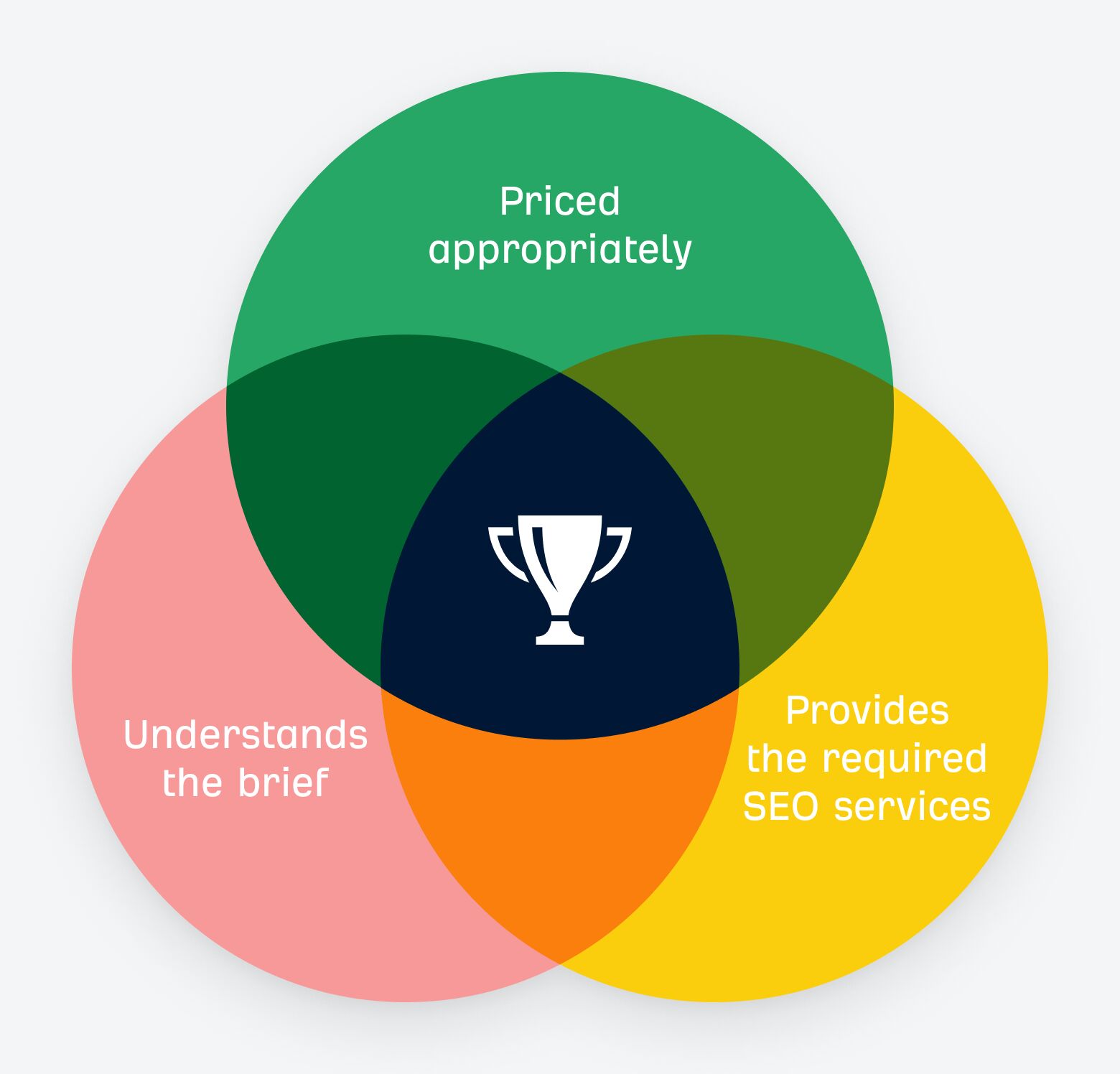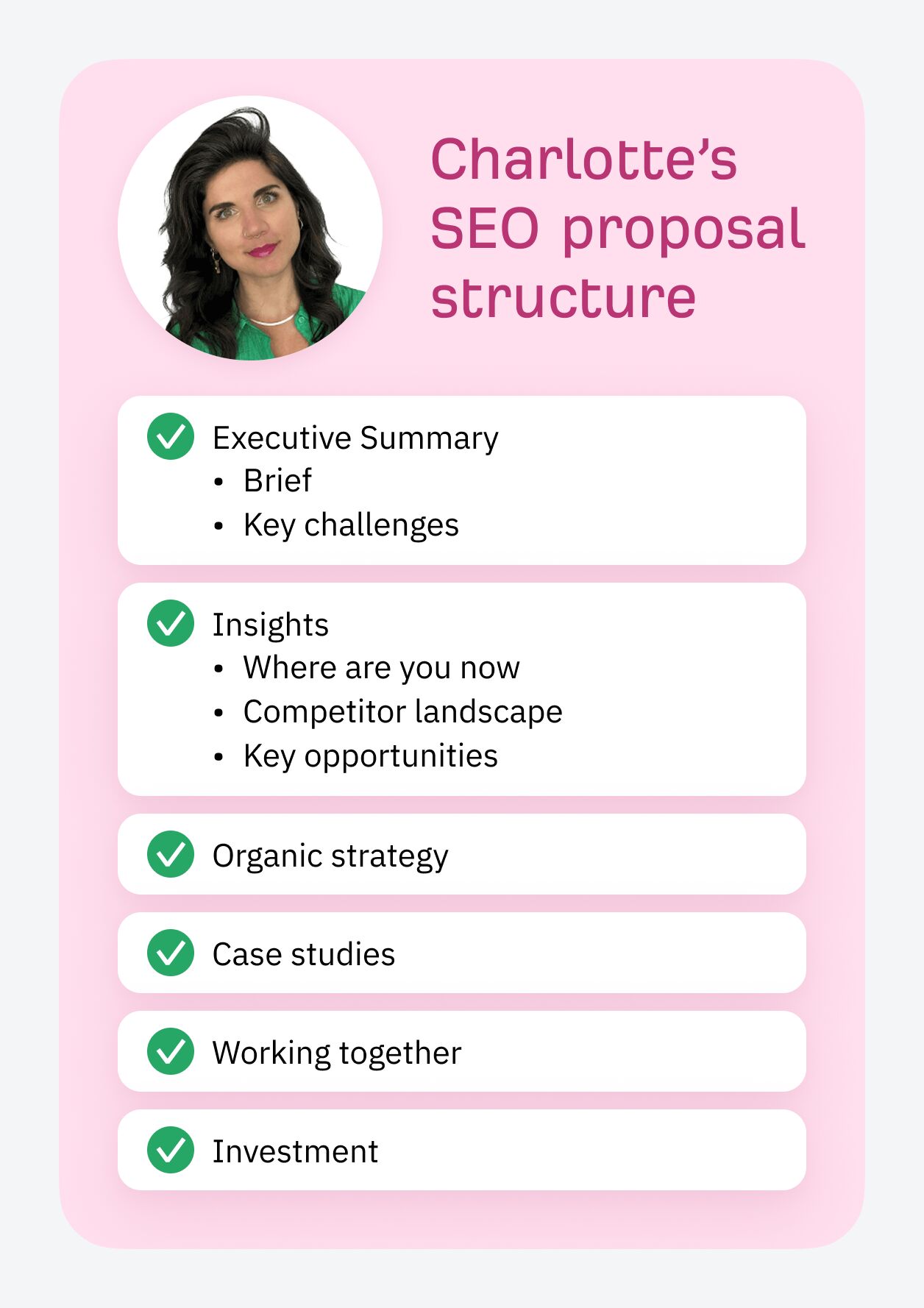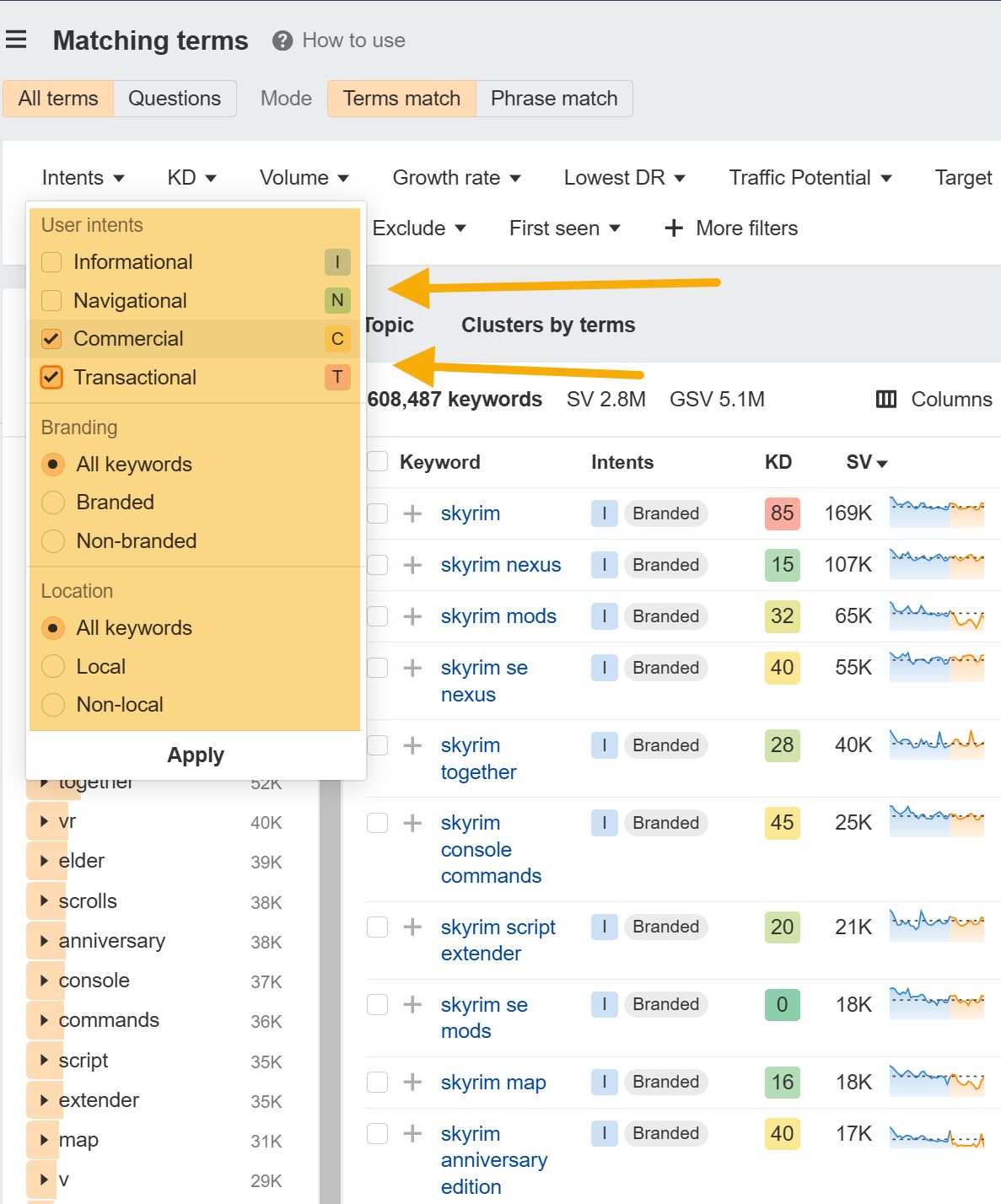
Want to win new business with your next SEO proposal? Let me show you how.
In this article, I’ll explain what an SEO proposal is and how to craft it to win over the prospective client. I’ll share my SEO proposal template based on my agency experience and tips from the SEO pros to give you the edge in your next SEO proposal.
An SEO proposal is a document (usually slides) that outlines services an SEO agency or consultant intends to provide to improve a website’s Google rankings—for a fee.
It has two functions: first, as a persuasive sales pitch, and second, as a blueprint for the proposed SEO work.
An SEO proposal is your manifesto for improving the SEO of the client’s website. It’s used to close business—so it needs to be persuasive.
So, what does a good proposal look like?
- Good SEO proposals – Clearly communicate the scope of work, prioritize important issues, and provide the SEO services required at an appropriate price
- Bad SEO proposals – Misunderstand the brief, communicate poorly, don’t provide the required SEO services at an appropriate price
In short, to stay on the winning side, you must balance these three things against each other.
Every website has unique SEO challenges, so every detail of an SEO proposal cannot be templated.
Your input is still required to create an SEO proposal to convince prospective clients to do business with you.
However, having looked at many SEO proposals over the years from working in various SEO agencies, there’s a structure that I’ve seen in many SEO proposals:
- Title card
- Introduction
- Brief
- Insights and recommendations
- Project timeline
- Pricing
I’ve converted this structure into an SEO proposal template below, which you can quickly modify for your next pitch. You can personalize this template any way you want.
Here’s what it looks like, with an explanation of each section.
Title Card
Your title card is the first thing that your prospective client will see.
Here’s what it should include:
- Date
- Prospective client’s website URL
- Logo of the website

I’ve kept it minimal to illustrate the key elements.
Introduction
It’s easy to get carried away with introducing yourselves and explaining your methodology and work processes. But it’s best to keep this section as brief as possible—I liked to keep it to three key slides.
- Introduce your team – put names to faces, explain who you are
- Show your expertise – share clients you have worked with
- Share your recent results – show the results of a recent client you’ve worked with

Sharing the clients that you’ve worked with is something that I have seen almost every agency I’ve worked at do. It acts as social proof that your SEO services are legitimate.

Sidenote.
If you are just starting and don’t have any clients yet, include your website or skip this slide altogether.
Lastly, it’s a good idea to provide one key example of your recent work.
You can share a screenshot of your organic traffic from Site Explorer’s Overview page or Google Search Console. It often helps if the example is related to the work you are pitching for.

Tip
Use Ahrefs’ Site Explorer’s new content changes feature to show how the content changes you made helped increase organic traffic.

Brief
It’s a good idea to re-confirm your client’s SEO goals in writing to underline that you understand the prospective client’s brief. For example, you could boost traffic to certain pages and improve rankings for different search terms.
Here’s a quick example of what that might look like.

Tip
Have a “discovery call” with the prospective client beforehand. Take notes detailed from this call, and use them for this section.
Insights & recommendations
Your insights and recommendations are the meat of your SEO proposal. But where do you get the meat from? SEO tools like Ahrefs can provide a technical and performance analysis of any website.
There are two key tools I use to create SEO insights: Ahrefs’ Site Explorer and Ahrefs’ Site Audit. Between these two tools, you should be able to find performance and technical issues.
I’ve added some useful resources below to help you tackle some of the more common SEO issues and mistakes that could help complete this section.
Further reading
Project timeline
Once you’ve outlined the key issues and recommended specific SEO services, it’s a good idea to create a project timeline to show your prospective client how you will deliver the work.
The best format for this is usually a Gantt chart supplemented with commentary to provide extra information.

Pricing
Pricing your services is one of the biggest hurdles if you’re new to SEO—how much should you charge?
Luckily, Joshua Hardwick researched what SEOs charge, and you can use our SEO pricing post as a guide to what you should charge.
Your pricing typically depends on three things: what type of business you’re running:

Where you are in the world.

And your years of experience.

Once you’ve decided on your rate, you can decide what services the prospective client requires, the delivery method, and the cost.
The best format for all this information is usually a pricing table like the one below.

Optional: SEO forecast
It’s not compulsory to include an SEO forecast in your SEO proposal, but it’s a good idea as a follow-up document if you want to demonstrate the value of your SEO services.

I don’t usually include a forecast at this stage because SEO forecasting can take time and usually requires access to first-party data like Google Analytics or Google Search Console. The reason is at the proposal stage, clients are sometimes reluctant to provide access to their first-party data.
Further reading
Steal our SEO proposal template

If you want to use the above structure, you can steal our SEO proposal template. Start by making a copy by clicking the link below.
Click here to make a copy of our SEO proposal template
SEO proposal tips from the pros
Now that we have the basic structure, you can add some extra sparkle to your SEO proposal. I spoke to five SEO professionals to get their tips on creating a great SEO proposal.
James Norquay – Prosperity Media

“My advice for making a great proposal is to investigate the business in detail and understand the company in a discovery call. Learn what the pain points are from the prior activity. You also want to ensure the prospect has the correct expectation when it comes to results and activity completed.”
James’ recommended tools
- Custom Google Looker Studio templates
- Excel & Google Sheets
- Ahrefs
- Screaming Frog
- Data for SEO
- Sitebulb
James’ SEO proposal structure

Charlotte Tomlinson – Distinctly

“Include very little generic content — ensure everything is 100% tailored to the client, their industry, and their target customers.
Avoid numerous slides on your agency’s processes and methodology and instead focus on the challenge, the research, and what you will do to achieve the client’s goals. It’s also helpful to launch straight into the interesting stuff (the research, strategy) rather than covering lots about your agency at the beginning—you want to capture their attention as soon as possible.”
Charlotte’s recommended tools
Charlotte’s SEO proposal structure

Liam Quirk – Quirky Digital:

“When it comes to creating a successful SEO proposal, my top tip is to weave in a case study from a campaign with a similar budget.
Actual results and proven methods build trust and show you can deliver under similar conditions.
From my experience, this tangible evidence can sway potential clients effectively and sometimes leads to further questions about the campaign.
Additionally, reference campaigns with similar deliverables and provide a timeline for when you expect the needle to move.
Clear timelines manage client expectations and highlight your expertise in delivering measurable outcomes.”
Liam’s recommended tools
- Ahrefs’ Site Explorer
- Keyword Insights
- Screaming Frog
- Google Analytics
- Google Search Console
Liam’s SEO proposal structure

Itamar Blauer – Studiohawk

“The most important part of an SEO proposal is to demonstrate that you understand what pain points the business has, along with the context of their website’s history, and then matching this with the appropriate prioritization”
Itamar’s recommended tools
Itamar’s SEO proposal structure

Imogen Davies – Imogen Davies SEO Consultancy

“Look at the site, listen to what it is the prospective client is asking for, understand what they’ve done before, and then show why and how what you’re suggesting should be done.
Run a technical audit, check the rankings and SEO visibility, and if you can get access to GA4/GSC then check the trends and traffic contribution. See what’s working and what needs fixing, then base the proposal on the areas where the biggest impact will be seen over time.
Show how everything is linked. For example, “We need to fix this indexing issue so that in 3 months, these other areas start to build up, and in 6 months, we’ll be in a position to do XYZ.” If you can show how everything is connected, it goes from a list of “things that should be done” to the foundations of a strategic roadmap.”
Imogen’s recommended tools
- Ahrefs’ Site Explorer – for ranking history, visibility history traffic share, and keyword movement
- Screaming Frog
- Excel
Imogen’s SEO proposal structure

Final thoughts
An SEO proposal is your ticket to new business, so you need to get it right—or you’ll lose the prospective client.
It may seem like a lot of pressure for one document—but if you start with our template, tailor it, and focus on providing thoughtful insights and recommendations using SEO tools like Ahrefs, you’ll win your next SEO client in no time.
Want to contribute to this post? Add your thoughts here or message me on LinkedIn.
Content Copyrights Belong to The Author. All Rights Reserved.
We're A Dallas Digital Marketing Agency That is Experts At Social Media Marketing, Website Design and Emarketing and Promotion.



